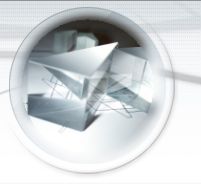
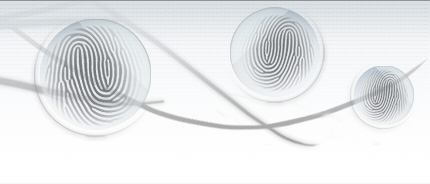
A technical evaluation of fingerprint scanners
Several fingerprint scanners have been recently introduced in the biometric market, so that is quite difficult for inexpert users to understand the technological differences and the features which determine the scanner quality and performance.
-
A technical parameter of great importance is the resolution, that is the number of pixels per inch (dpi) characterizing the acquired images. Intuitively, the higher the scanner resolution is, the finer are the details that can be extracted from a fingerprint image. A 500 dpi resolution is required by FBI-compliant systems. The figure below compares the same fingerprint portion as acquired at 500 dpi and at about 350 dpi. The Biometrika's scanner Fx2000 and Fx3000 operate at a resolution of 569 dpi, even greater than that required by FBI. The fingerprint images acquired through the Fx2000 and Fx3000 scanners can be easily subsampled at 500 dpi in case Fx2000 and Fx3000 have to be used in conjunction with other professional scanners operating at such resolution.
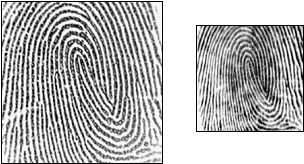
-
A fundamental technical feature is undoubtedly the size of the scanner sensing area; in fact, this parameter determines the size of the fingerprint portion which can be acquired by the scanner. This parameter usually lies in the range 1.0x1.0 square inches of some professional models to about 0.38"x0.38" of some low profile models. It is worth noting that in the second case the captured portion is about 7 times smaller than in the first case. Why a wide sensing area is so important? The size of an average fingerprint is about 0.5"x0.7" (smaller for children and females, larger for adult males) and therefore the acquisition of a fingerprint with a sensing area smaller than 0.5"x0.7" produces a partial fingerprint; this effect gets worse by the problem of partial overlapping between different acquisitions of the same finger due to unavoidably positioning changes. The figure below shows 2 different acquisitions of the same finger as produced by a solid state scanner with a 0.384"x0.384" area.
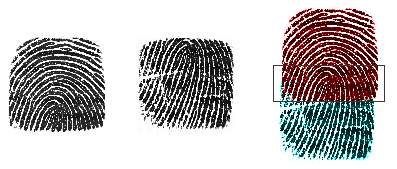
It is well evident from the figure that the common part of the fingerprint is quite limited (see the rectangle on the right): as a consequence the accuracy and reliability of fingerprint recognition are heavily compromised. The small overlapping area between fingerprint acquired at different times is undoubtedly one of the main causes of false rejections (FRR) in fingerprint-based biometric systems. The Biometrika Fx2000 scanner is characterized by a wide sensing area of 0.98"x0.52" (25x13.2 mm2) which allows most of the fingerprints to be entirely acquired. The Biometrika Fx3000 scanner has even a larger area: 0.7"x0.98" (17.8x25 mm2). Why the area is so elongated in vertical direction? Whilst horizontal positioning errors are rather small, due to the mechanical shape of the scanner which drives the user toward an optical horizontal alignment, the vertical positioning differences are usually larger due to the practical impossibility of effectively constraining the finger in vertical direction for the presence of nails and for the need of dealing with fingers of different lengths. The vertical size of Biometrika's scanners, which is comparable with some professional models of significantly higher cost, allows the false rejection caused by inaccurate positioning to be drastically reduced. The following figure compares the same fingerprint as acquired by Fx3000, Fx2000 and by one of the most diffused solid state scanner (fingerprint images are shown at right proportions).
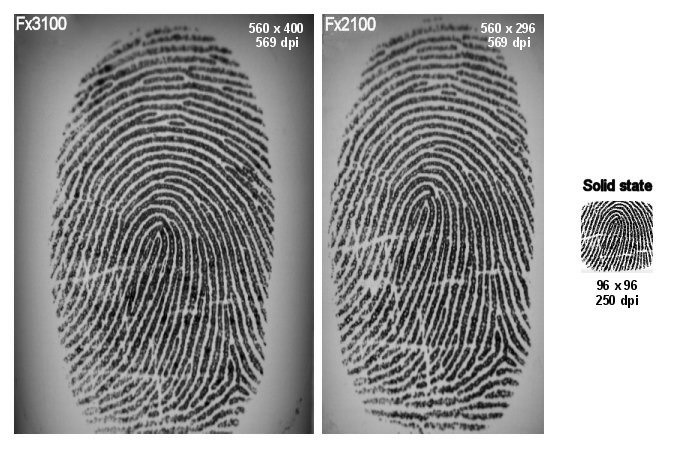
For more details about fingerprint scanners and their features, see chapter 2 of the Handbook of Fingerprint Recognition (an extract from chapter 2 is available on-line). The above book compares several existing commercial scanners (Fx2000 included) by providing numerical features such as area and resolution but also showing images of the same finger as acquired by the different scanners under various skin conditions (normal, dry, wet, poor quality).
-
Besides the resolution and the size of the sensing area, the images produced by a fingerprint scanner are characterized by other factors which determine their neatness, contrast and geometric distortion. A deep analysis of these aspects is beyond the aim of this document.
-
Another important feature, especially in high security application, is the protection of the data and images which are exchanged between the scanner and the connected PC. Few scanners in the market use encryption techniques and non-repeatable keys to avoid eavesdropping or other possible active attacks; on the other hand, the low computation power of the micro controllers (often 8 bits) mounted on most of the above models, makes it not possible to implement state-of-the-art encryption techniques. The Biometrika Fx2000 scanner is equipped with a 32 bit RISC processor (20 MIPS) and implements very reliable symmetric encryption algorithms with 128-bit keys.
-
Biometrika Fx3000 scanner is not a simple acquisition device, but a complete fingerprint recognition system, capable of performing on-board image acquisition, feature extraction, template storage and matching. The PC connected to the scanner is not involved in processing the biometric data: images and templates of the users are not transferred to the PC, thus increasing security and privacy.
Optical or Solid State?
The most spread scanner technologies are: optical and solid state:
-
Optical: a prism/lens system focuses the image on a CCD or CMOS sensing element; the parameters of the optical system allows the resolution to be controlled independently of the sensing element active area.
-
Solid State: a 2d array (matrix) of micro-cells is built in a silicon chip and directly touched by the finger; each micro-cell is a tiny sensor itself capable of reading a fingerprint pixel. The size of the scanner sensing area exactly coincides with the size of the silicon area. All the solid state sensors are usually called capacitive sensors; actually, capacitive sensors constitute a subclass of the solid state sensors which also include: Thermal, Radio frequency and Pressure sensors.
The solid state technology, younger than the optical one,
has the undoubted advantage of allowing a greater miniaturization of the
scanner, and this makes it more well-suited for the integration into small
devices, like mobile phones, palmtops, ...
On the other hand, many are
the advantages of the optical scanners with respect to the capacitive
ones:
-
Sensing area: manufacturing large and pure silicon chips is difficult and rather expensive; therefore, the solid state sensors nowadays available in the market are characterized by a small area.
-
Robustness and lifetime: the silicon surface is in direct contact with the finger, or sometimes protected by a very thin coating, makes the solid state scanners rather weak with respect to mechanical damages or (in the case of capacitive sensor) to electrostatic charges. If the acquisition surface of an optical scanner is damaged, the prism substitution involves a cost which is negligible with respect to the scanner cost, whereas for a solid state scanner the cost of the sensing elements is dominant. The lifetime of a solid state scanner is usually shorter than optical's.
-
Maintenance: solid state scanners need a more frequent cleaning, to remove from the sensor surface deposits of grease or dirt left from the fingers which highly deteriorate the quality of the acquired images.
Several experiments, carried out by well-known international research groups (Michigan State University, Biometric System Laboratory), show that the same recognition algorithms produced error rates significantly higher when images were acquired by using solid state scanners (for details Fingerprint Matching: Data Acquisition and Performance Evaluation, Technical Report MSU-CPS-99-14) and Second International Competition of Fingerprint Verification Algorithms (FVC2002). Finally, in the paper "Fingerprint verification by decision-level fusion of optical and capacitive sensors", presented at BioAW-2004 (Prague), the recognition accuracy obtained over a database collected through Fx2000 is 5.78 times greater than the accuracy obtained using a capacitive scanner.


